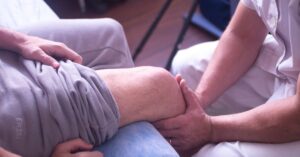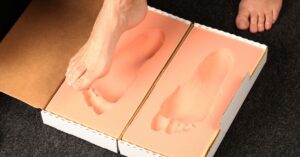Cause
In most cases, the irritation or compression is caused by an intravertebral disc bulge, or protrusion, that presses upon one of the lumbar spinal nerves that join to form the sciatic nerve. Sometimes, with severe degenerative disc disease, the sciatic nerve is pinched by bone ‘spurs’, but in most cases, it is bulging discs and/or ligaments responsible for the pain.
Disc bulges, protrusions and degeneration
Sciatica is often, but not always accompanied by chronic and/or severe low back pain. When there is no low back pain, patients are often surprised to find out the pain originates in their lower back. Sometimes sciatica can be caused by ‘piriformis syndrome,’ a condition where the piriformis muscle under the Gluteus muscles goes into spasm and squishes the sciatic nerve that travels under or through the piriformis muscle. A physical examination can usually differentiate the two causes.
Treatment
Sciatica is relieved by treatments that remove the pressure, or irritation, from the nerve. Occasionally, your body can heal this by itself or for 4 to 12 weeks. Still, more often, it needs help to shrink the bulging or protruding disc. To understand how treatments can help, you first need to understand the pathology of intravertebral disc bulges, disk protrusions and disc degeneration. Intravertebral discs are avascular (i.e. they have no blood supply), but they need the water, oxygen, sugar and other nutrients carried by the blood, so they developed a way to use your bodyweight when upright to squish the disc (like squishing a wet sponge) and squishing out the dirty water out of the disc. Then when lying down, the disc pushes the vertebrae (bones) apart, which draws fluids and nutrients into the disk. However, when the disc is injured, this process no longer works, so the fluids and nutrients the disc needs to heal itself cannot get into the disc, so the injury does not heal, and the pain goes on and on.
The best way to get the injury to heal, and get long-term pain relief, is nonsurgical spinal decompression, which slowly pulls the vertebrae apart, creating a suction force inside the disc (like pulling on a syringe plunger) which draws the fluids and nutrients in, allowing the disc tear to heal. As it heals, the back pain eases, and the disc bulge or protrusion shrinks away from the nerve, relieving sciatica.
Another way to treat this problem is with a Cortizone injection. Cortizone is an anti-inflammatory, so if inflammation is the main component of your pain, you can get relief from the bad pain and or sciatica. Unfortunately, the success rate long-term is much lower than spinal decompression. Still, it does provide short-term relief for some people, which is welcomed.
Back surgery which removes the protruding part of the disc (microdiscectomy), can relieve sciatica but usually does not help with the lower back pain. Surgery is recommended only for the worst cases. Other treatments, such as spinal decompression, will usually have to resolve this problem long before you can get surgery. Spinal decompression does not have the severe potential side effects of back surgery has.




